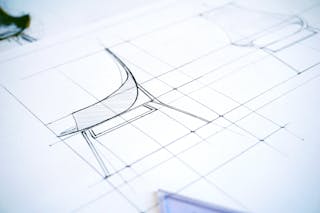
Surface pattern design is a field of design that focuses on the decorations and patterns found on surfaces. It is a field of great creativity and potential, and those who enter it can find many different ways to express their own style and personality. There are a few tips, however, that can help any surface pattern designer, no matter what their level of experience, to create beautiful, original, and successful designs.
The first step to becoming a surface pattern designer is finding your own unique design style. This can be done by looking at the work of other designers, both inside and outside of the field of surface pattern design, and taking note of what you like and don’t like. Once you have a good understanding of the different design styles that exist, you can start to experiment with your own, mixing and matching different elements until you find a style that feels right for you. It is important to remember that there are no “right” or “wrong” styles, so don’t be afraid to experiment and be creative!
After you have found your design style, the next step is to start creating some designs! If you’re not sure where to start, a great way to get some inspiration is to look for images online or in magazines that you think would make interesting patterns. Once you have found some inspiration, the next step is to start translating that inspiration into your own designs. This can be done by hand or using design software on your computer. If you’re new to design, it can be helpful to start by creating simple shapes and patterns, and then gradually adding more complexity as you become more confident in your abilities.
Once you have created a few designs, the next step is to start thinking about how you can turn those designs into actual products. This can be done by printing your designs onto fabric or paper, or by creating digital products like wallpaper or desktop backgrounds. If you’re interested in selling your designs, there are a number of different options, including licensing your designs to companies or individuals, or selling products that you have created yourself. Regardless of how you choose to sell your designs, the important thing is to get your work out there and start building a portfolio that showcases your skills and style.
Surface pattern design is a rewarding and challenging field that offers designers a great deal of creative freedom. By following the tips above, you can start to develop your own style
What is a surface pattern designer?
As a surface pattern designer, you are responsible for creating Repeat patterns for textiles, wallpapers, Giftwares and other products. Your designs must be marketable, on trend and easy to reproduce. You are also required to have a strong understanding of design principles, surface design techniques, digital design software and photography.
A successful surface pattern designer will have a strong portfolio of work that showcases their signature style. They will be proficient in multiple design software programs and have a strong understanding of color, repeat and layout. They will also have a keen eye for detail and be able to take a design from concept to completion.
When working on a surface design project, you will be responsible for researching trends, developing concepts, creating mood boards, designing patterns and working with clients to ensure their vision is met. You must be able to work to deadlines and within budget constraints.
If you are interested in becoming a surface pattern designer, you will need to have a strong understanding of design principles and a creative eye. You will also need to be proficient in multiple design software programs and have a strong portfolio of work to showcase your skills.
What does a surface pattern designer do?
As a surface pattern designer, you will be responsible for the creation of original artwork that can be used for a wide range of products, including textiles, wallpaper, stationery, and giftware. Your role will involve coming up with new ideas and designs, as well as developing existing ones, and you will need to be able to work to briefs set by clients or companies.
You will need to be highly creative and have a strong understanding of colour, composition, and design principles. Good drawing skills are also essential, as well as the ability to use design software such as Adobe Photoshop and Illustrator.
As well as generating new ideas, you will also be responsible for seeing projects through from start to finish, which will involve liaising with clients, manufacturers, and other members of the team. Good organisational and communication skills are therefore essential.
Surface pattern design is a rapidly growing industry, so it is important to keep up to date with the latest trends. This can involve attending trade shows, reading design magazines, and networking with other designers.
What are the requirements to be a surface pattern designer?
In order to be a surface pattern designer, there are many requirements that must be met. First and foremost, one must have an eye for aesthetics and a strong sense of design. It is also important to be proficient in a variety of software programs, as this will be necessary for creating patterns. Additionally, it is helpful to have a background in art or design, as this will give you a better understanding of various design principles. Finally, it is also important to be able to work well under pressure and to deadlines, as surface pattern design can often be a fast-paced and deadline-driven industry.
What are the challenges of being a surface pattern designer?
As a surface pattern designer, one of the challenges you may face is finding ways to create new, fresh designs that stand out amongst the sea of patterns that already exist. It's important to be aware of current trends and styles, but it's also important to strike a balance between being trend-aware and keeping your own unique style.
Another challenge you may face is working with clients who have specific ideas or expectations in mind for their project. It can be tricky to try to meet the client's vision while still staying true to your own style, but it's important to remember that it's the client's project and they are ultimately the ones who need to be happy with the end result.
A third challenge that surface pattern designers may face is copyright and intellectual property infringement. With the proliferation of social media and online sharing, it's easier than ever for someone to steal another person's designs. If you find that someone has copied your work, it can be difficult to protect your copyright and get the credit and compensation you deserve.
Despite the challenges, being a surface pattern designer can be an incredibly rewarding and creative profession. It's a great way to combine your love of art and design with your own unique sense of style to create something beautiful that others can enjoy.
How can I become a surface pattern designer?
There is no one-size-fits-all answer to this question, as the best way to become a surface pattern designer may vary depending on your individual skills and interests. However, some potential ways to become a surface pattern designer include studying art and design, pursuing a degree in a relevant field, and/or completing an internship or apprenticeship with a professional surface pattern designer. Additionally, keeping up with trends in the industry and networking with other professionals can also help you to become a successful surface pattern designer.
What are some tips for becoming a successful surface pattern designer?
In order to become a successful surface pattern designer, there are a few key things you should keep in mind. First and foremost, you need to have a strong understanding of the design process and the elements of design. This includes understanding colors, compositions, and patterns. Secondly, you must be proficient in the use of software programs like Adobe Photoshop and Illustrator. Strong computer skills are a must in this field. Third, it is important to have a strong portfolio that showcases your best work. This will help you land clients and assignments. Finally, you must be willing to work hard and be flexible in order to succeed in this competitive industry.
Frequently Asked Questions
What is surface pattern design in practice?
The practice of surface pattern design is a way to create artwork that can be mass-produced on a product surface. Surface pattern designers are expected to be proficient with repeat patterns and also the value and balance of creating an engineered design.
What is surface design?
Surface design is a type of artwork that is created specifically to be applied as surface decoration.surface pattern define surface pattern design, One technique used to create unique and interesting finishes on various surfaces is by applying patterns or designs. This can be done with a brush, roller, or airbrush.
Are You 100% sure what surface pattern design consists of?
There is no one answer to this question as surface pattern design can vary depending on the context and situation in which it is used. However, general characteristics of surface pattern design may include: -The use of repeating textures or patterns on an external surface. -The creation of an image or effect by combining these textures and patterns.
How many patterns should you make before you design?
This question is a little more difficult to answer. You should make as many patterns as you can while maintaining efficiency and quality. However, it's also important to not overshoot and end up making too many unpractical or unusable designs. Starting out with around 50-100 creative Patterns will give you the foundation to create successful illustrations and designs without overwhelming yourself.
What is surface pattern design?
Surface pattern design is any design, illustration, drawing, or motif that is destined to be printed or applied to a surface, no matter what type of surface that might be. In many cases, the designer will create a highly detailed draft for a specific project before beginning the actual painting or graphic design work. This level of attention to detail often results in a more complex and intricate design than would typically be seen on most surfaces.


